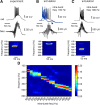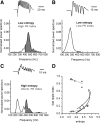Emergent dynamics of fast ripples in the epileptic hippocampus
- PMID: 21123571
- PMCID: PMC6634823
- DOI: 10.1523/JNEUROSCI.3357-10.2010
Emergent dynamics of fast ripples in the epileptic hippocampus
Abstract
Fast ripples are a type of transient high-frequency oscillations recorded from the epileptogenic regions of the hippocampus and the temporal cortex of epileptic humans and rodents. These events presumably reflect hypersynchronous bursting of pyramidal cells. However, the oscillatory spectral content of fast ripples varies from 250 to 800 Hz, well above the maximal firing frequency of most hippocampal pyramidal neurons. How such high-frequency oscillations are generated is therefore unclear. Here, we combine computational simulations of fast ripples with multisite and juxtacellular recordings in vivo to examine the underlying mechanisms in the hippocampus of epileptic rats. We show that populations of bursting cells firing individually at 100-400 Hz can create fast ripples according to two main firing regimes: (1) in-phase synchronous firing resulting in "pure" fast ripples characterized by single spectral peaks that reflect single-cell behavior and (2) out-of-phase firing that results in "emergent" fast ripples. Using simulations, we found that fast ripples generated under these two different regimes can be quantitatively separated by their spectral characteristics, and we took advantage of this separability to examine their dynamics in vivo. We found that in-phase firing can reach frequencies up to 300 Hz in the CA1 and up to 400 Hz in the dentate gyrus. The organization of out-of-phase firing is determined by firing delays between cells discharging at low frequencies. The two firing regimes compete dynamically, alternating randomly from one fast ripple event to the next, and they reflect the functional dynamic organization of the different regions of the hippocampus.
Figures







Similar articles
-
Ripples Have Distinct Spectral Properties and Phase-Amplitude Coupling With Slow Waves, but Indistinct Unit Firing, in Human Epileptogenic Hippocampus.Front Neurol. 2020 Mar 24;11:174. doi: 10.3389/fneur.2020.00174. eCollection 2020. Front Neurol. 2020. PMID: 32292384 Free PMC article.
-
Extracellular calcium controls the expression of two different forms of ripple-like hippocampal oscillations.J Neurosci. 2014 Feb 19;34(8):2989-3004. doi: 10.1523/JNEUROSCI.2826-13.2014. J Neurosci. 2014. PMID: 24553939 Free PMC article.
-
Reduced spike-timing reliability correlates with the emergence of fast ripples in the rat epileptic hippocampus.Neuron. 2007 Sep 20;55(6):930-41. doi: 10.1016/j.neuron.2007.07.040. Neuron. 2007. PMID: 17880896
-
Network mechanisms for fast ripple activity in epileptic tissue.Epilepsy Res. 2011 Dec;97(3):318-23. doi: 10.1016/j.eplepsyres.2011.03.006. Epub 2011 Apr 5. Epilepsy Res. 2011. PMID: 21470826 Free PMC article. Review.
-
High-frequency oscillations: what is normal and what is not?Epilepsia. 2009 Apr;50(4):598-604. doi: 10.1111/j.1528-1167.2008.01917.x. Epub 2008 Dec 4. Epilepsia. 2009. PMID: 19055491 Review.
Cited by
-
Nonictal EEG biomarkers for diagnosis and treatment.Epilepsia Open. 2018 Sep 17;3(Suppl Suppl 2):120-126. doi: 10.1002/epi4.12233. eCollection 2018 Dec. Epilepsia Open. 2018. PMID: 30564770 Free PMC article.
-
Changes in Physiological and Pathological Behaviours Produced by Deep Microelectrode Implantation Surgery in Rats: A Temporal Analysis.Behav Neurol. 2020 Mar 9;2020:4385706. doi: 10.1155/2020/4385706. eCollection 2020. Behav Neurol. 2020. PMID: 32211080 Free PMC article.
-
Theta/gamma Co-modulation Disruption After NMDAr Blockade by MK-801 Is Associated with Spatial Working Memory Deficits in Mice.Neuroscience. 2023 May 21;519:162-176. doi: 10.1016/j.neuroscience.2023.03.022. Epub 2023 Mar 28. Neuroscience. 2023. PMID: 36990270 Free PMC article.
-
Gap junction networks can generate both ripple-like and fast ripple-like oscillations.Eur J Neurosci. 2014 Jan;39(1):46-60. doi: 10.1111/ejn.12386. Epub 2013 Oct 14. Eur J Neurosci. 2014. PMID: 24118191 Free PMC article.
-
RIPPLELAB: A Comprehensive Application for the Detection, Analysis and Classification of High Frequency Oscillations in Electroencephalographic Signals.PLoS One. 2016 Jun 24;11(6):e0158276. doi: 10.1371/journal.pone.0158276. eCollection 2016. PLoS One. 2016. PMID: 27341033 Free PMC article.
References
-
- Adrian E. Discharge frequencies in the cerebral and cerebellar cortex. Proc Phys Soc. 1935;83:32–33.
-
- Andersen P, Bliss TVP, Skrede KK. Unit analysis of hippocampal population spikes. Exp Brain Res. 1971;13:208–221. - PubMed
-
- Bernard C, Anderson A, Becker A, Poolos NP, Beck H, Johnston D. Acquired dendritic channelopathy in temporal lobe epilepsy. Science. 2004;305:532–535. - PubMed
